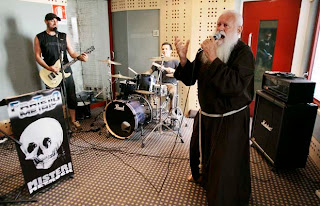With Canadian primeminister stephen Harper soon visiting India, i was googling to find some more info on it.
Here is an article by Haroon Siddiqui in www.thestar.com
( http://www.thestar.com/comment/article/724584)
.....................................................................................................................................
Tips for Harper's trip to India
Ottawa has been far too slow to recognize its dynamic economy and geopolitical clout
If I were Stephen Harper and going on my first visit to India – landing in Mumbai Sunday to meet business leaders, then New Delhi to confer with Prime Minister Manmohan Singh and others – I'd do the following:
Ignore the Canadian media's portrayal of India as orientalist exotica and the epicentre of some of the world's worst problems.
India is also an economic and geopolitical giant, in some respects more important than China. Besides democracy and English, it boasts a population that's much younger than China's.
Its $1 trillion economy equals Canada's, and is growing at 6.7 per cent this year, compared with the stagnant economies of the West.
India is spending as much as Canada, more than $1 billion, on development projects in Afghanistan.
India's army is the fourth largest in the world. Its navy rules the Indian Ocean. Its capacity to build satellites, missiles, fighter jets, etc. exceeds ours.
India is a serious global player.
Understand also that Ottawa has been painfully slow to recognize this reality.
The U.S. has been wooing India for years. Bill Clinton's 1999 visit was one of the best foreign policy charm offensives I've ever seen. George W. Bush followed with a realpolitik gift of a civilian nuclear deal, setting aside American anger over India turning nuclear and balking at the Non-Proliferation Treaty.
Russia and France have since negotiated their own accords, wanting to tap the $100 billion bonanza of Indian nuclear energy needs.
Ottawa could have taken a principled stance and refused to sell uranium (as has Australia). Or it could have stopped acting peeved and opened some doors for our (largely Ontario-based) nuclear sector.
It did neither and has been plodding along, despite Harper's initial enthusiasm. Unless he has something dramatic to say, a photo-op on the nuclear file will only draw yawns in Delhi.
Know that while bilateral trade jumped to $4.6 billion in 2008, rising by a fifth over 2007, India's trade with the U.S. and China rose proportionately more (each now in the $45 billion range).
Believe it or not, India is investing more in Canada than we are there ($1.02 billion vs. $800 million). Indian conglomerates have taken over Canadian firms in the forestry, steel and pharmaceutical sectors, and are using Canada as a gateway to the U.S.
Remember that there are 100,000 Indian students in the U.S., 80,000 in Australia, 30,000 in the U.K. but only 4,000 in Canada.
This even though our universities are top-notch, cost less and provide a welcoming environment (unlike Australia, where Indian students have faced racist incidents). Plus Ottawa is offering foreign students the opportunity to eventually apply for immigrant status (eminently sensible, given that they're likely to integrate more easily).
"My assumption is that Canada does not sell itself aggressively in India," says S.M. Gavai, India's high commissioner in Ottawa.
Not just that. The provinces compete with each other in India. And they and the feds don't coordinate their actions.
"Canada has lagged hopelessly behind in the higher education field," writes David Malone, our former high commissioner to India (2006-08), one of our most successful envoys there. His article, Building Stronger Ties Between India and Canada: Better Late Than Never, posted on the Asia Pacific Foundation website, is very much worth reading.
Resist partisanship and promote the visits to India of Dalton McGuinty (Dec. 6-11, his second) and Jean Charest (in February).
Some Ontario universities – York, McMaster, Toronto, Waterloo and Windsor, in particular – have been working hard to forge links in India. They could use a prime ministerial push.
So could the 25 clean energy companies going with McGuinty.
Don't lecture the Indians on the environment. They, like the Chinese, balk at binding limits on carbon emissions.
India will not be deprived of economic uplift, especially by those who have been polluting for a century or more.
To the counter-argument that global warming cannot be reduced without India's and China's help, India says: If that's the case, subsidize our conversion to green technologies. What's our response?
It is what many Indian scientists themselves are saying: India cannot reach its economic goals amid environmental degradation: deforestation, sinking water tables, rising salinity, drying rivers and lakes.
Joint projects are the way to go.
Don't let Prime Minister Singh's modesty, mild manner and soft voice lull you into forgetting that he is one of the world's foremost economists, who also happens to hold power. Ditto his economic adviser, Montek Singh Ahluwalia (who was in Toronto in April, for an energy conference).
Don't even try to play in their economic league. Cultivate them instead on what interests them – India's role in the G20, which Canada is hosting next June in Huntsville, and for which Ahluwalia is India's designated envoy.
Prevail on Prime Minister Singh to also visit Montreal to receive his honourary doctorate from McGill.
Treat him as the historic figure he is. He was the architect of India's economic turnaround in the 1990s as finance minister. With his innate decency and honesty, he has as prime minister single-handedly broken the decades-long grip of corrupt and parochial regional leaders, and restored a national vision, thereby positioning India for yet another giant leap forward.
http://www.thestar.com/comment/article/724584
Haroon Siddiqui is the Star's editorial page editor emeritus. His column appears Thursday and Sunday.
